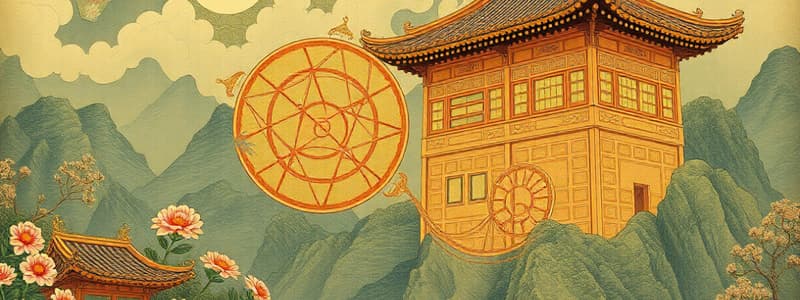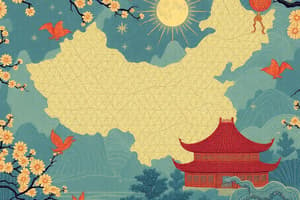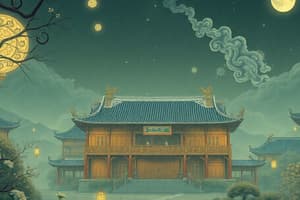Podcast
Questions and Answers
Which aspect of Chinese society did Confucianism primarily influence?
Which aspect of Chinese society did Confucianism primarily influence?
- Technological innovation and scientific advancement
- Military strategy and tactics
- Political and social structures and values (correct)
- Economic policy and trade regulations
What was a key difference by which the Qin dynasty's legalistic approach differed from Confucian ideals?
What was a key difference by which the Qin dynasty's legalistic approach differed from Confucian ideals?
- The Qin dynasty focused on strict laws and centralized control, whereas Confucianism promoted ethical behavior and social harmony. (correct)
- The Qin dynasty emphasized diplomacy and peaceful relations with neighboring states.
- The Qin dynasty prioritized agricultural development and rural communities.
- The Qin dynasty encouraged philosophical debate and intellectual freedom.
What was the primary construction material used to bind the bricks of the Great Wall of China together?
What was the primary construction material used to bind the bricks of the Great Wall of China together?
- Molten iron
- Glutinous rice flour (correct)
- A mixture of clay and straw
- Mortar made from lime and sand
What best reflects the Daoist approach to life?
What best reflects the Daoist approach to life?
How did the Han dynasty differ from the Qin dynasty?
How did the Han dynasty differ from the Qin dynasty?
In what way did life in Han dynasty cities contrast with rural life?
In what way did life in Han dynasty cities contrast with rural life?
Which of the following technological advancements was not developed in ancient China?
Which of the following technological advancements was not developed in ancient China?
What was the most significant impact of the Silk Roads during the Han dynasty?
What was the most significant impact of the Silk Roads during the Han dynasty?
How did the practice of scratching questions on oracle bones during the Shang dynasty contribute to Chinese society?
How did the practice of scratching questions on oracle bones during the Shang dynasty contribute to Chinese society?
During the Zhou dynasty, what was the main consequence of the decentralization of power and the appointment of family members as lords?
During the Zhou dynasty, what was the main consequence of the decentralization of power and the appointment of family members as lords?
How did the use of cast iron and bronze impact Chinese society during the Bronze Age?
How did the use of cast iron and bronze impact Chinese society during the Bronze Age?
How does the philosophy of Legalism, as articulated by Han Fei, propose to ensure a successful nation?
How does the philosophy of Legalism, as articulated by Han Fei, propose to ensure a successful nation?
What was Confucius's primary diagnosis of the societal issues during the decline of the Zhou dynasty, and what did he propose to resolve them?
What was Confucius's primary diagnosis of the societal issues during the decline of the Zhou dynasty, and what did he propose to resolve them?
How did Confucius believe that adherence to the Five Relationships would impact society?
How did Confucius believe that adherence to the Five Relationships would impact society?
What is the meaning of the quote from Lao-Tzu, “When I let go of who I am, I become what I might be?
What is the meaning of the quote from Lao-Tzu, “When I let go of who I am, I become what I might be?
Which geographical features are located to the west of China?
Which geographical features are located to the west of China?
Flashcards
Chang Jiang River
Chang Jiang River
A major river in central China, also known as the Yangtze River.
Family and Ancestor Reverence
Family and Ancestor Reverence
Respect for family and ancestors; a core value in Shang culture.
Shangdi
Shangdi
The deity to whom questions were posed on oracle bones during the Shang Dynasty.
Taoism and Confucianism
Taoism and Confucianism
Signup and view all the flashcards
Dynastic Cycle
Dynastic Cycle
Signup and view all the flashcards
Legalism
Legalism
Signup and view all the flashcards
Confucianism
Confucianism
Signup and view all the flashcards
Five Relationships
Five Relationships
Signup and view all the flashcards
Qin Dynasty
Qin Dynasty
Signup and view all the flashcards
Han Dynasty
Han Dynasty
Signup and view all the flashcards
Daoism
Daoism
Signup and view all the flashcards
Silk Roads
Silk Roads
Signup and view all the flashcards
Paper (Ancient China)
Paper (Ancient China)
Signup and view all the flashcards
Great Wall of China
Great Wall of China
Signup and view all the flashcards
Study Notes
- Major bodies of water surrounding China include the Yellow Sea, the East China Sea, and the Pacific Ocean, all located east of China.
- To the north lies the Gobi Desert and the Yellow River (Huang He).
- The Taklimakan Desert, the Himalayas, the Pamir, and the Tian Shan mountain ranges are to the west of China.
- The Chang Jiang (Yangtze) River is in central China.
Shang Dynasty
- Around 2000 BCE, farming communities evolved into cities.
- Shang kings controlled cities and established a dynasty.
- Respect for families and ancestors was fundamental to Shang culture.
- Oracle bones were used to pose questions to Shangdi, a deity.
- Priests inscribed questions on animal bones or tortoise shells, representing an early form of writing.
Zhou Dynasty
- The Zhou eventually overtook the Shang dynasty.
- Taoism and Confucianism are philosophies associated with the Zhou.
- Dynasties operate in a cyclical pattern.
- The Zhou dynasty lacked a strong central government, and family members were appointed as lords.
- Lords began to fight among themselves, leading to the "Time of the Warring States."
- Significant advancements occurred in bronze age technologies; cast iron and bronze were used for tools, vessels, and weapons.
- Han Fei created Legalism; Confucius and Lao-Tzu created Confucianism and Taoism, respectively.
- Confucius: "The strength of a nation derives from the integrity of the home," highlighting the importance of family values
- Taoism embraces change: "When I let go of who I am, I become what I might be."
- Legalism states structure is required: “Past and present have different customs; new and old adopt different measures...to drive a runaway horse without using reins or whip.”
Confucianism
- China entered a chaotic period during the Zhou dynasty.
- Confucius, a teacher and government official, believed Chinese society was collapsing due to conflict.
- Father and son, older and younger brother, husband and wife, and ruler and subject are the five relationships taught in Confucianism.
- Education, family unity, and filial piety were promoted by Confucius.
- After his death, Confucius' students compiled his teachings in a book called the Analects.
- Confucianism has served as a unifying force in Chinese culture and impacted millions.
Qin Dynasty
- The Qin dynasty unified China after the Warring States period.
- Imperial power was strengthened, and highway/irrigation projects were initiated.
- Weights, coins, writing, and measures were standardized.
- Shi Huangdi, a legalistic leader, tried to eliminate Confucian teachings.
- Construction of the Great Wall of China began along the northern border.
- The Great Wall is largely unrestored and primarily made by the Ming dynasty.
- Glutinous rice flour was used to bind the bricks.
- Erosion threatens the Great Wall.
- Near Qin leaders' tombs, the Terracotta Warriors were built over 2000 years ago.
- In ancient China, people believed in the afterlife and practiced human sacrifice.
- A special coating protected the Terracotta Warriors from decay.
Daoism and Legalism
- Lao-Tzu founded Daoism, focusing on harmony with nature.
- Daoists seek balance by connecting with nature.
- Han Fei led Legalism, which emphasized order through law and a strong centralized government.
- The Qin dynasty adopted Legalism.
Han Dynasty
- The Han dynasty, led by Liu Bang, defeated the Qin and supported Confucianism.
- Empress Lu led the dynasty for a time.
- The dynasty lasted 422 years.
- Emperor Wudi expanded the empire to nearly the size of modern China.
- People lived simple farming lives in mud houses.
- Han cities were very large metropolises with businesses, gangs and entertainment
Han Dynasty Innovations
- Ancient China invented the plow, collar harness for horses, wheelbarrow, and watermill.
- Paper was invented in 105 AD.
- Silk was highly valued.
- Cast iron production involved heating iron and pouring it into molds.
- The Silk Roads were trade routes connecting China and Europe.
- Chinese silk was in high demand.
- Cultures, grapes, honey, spices, ivory, pottery, and rugs were exchanged through the Silk Road.
- Buddhism spread to China, Japan, and Korea.
Studying That Suits You
Use AI to generate personalized quizzes and flashcards to suit your learning preferences.




